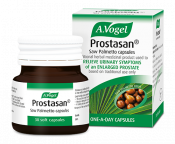Osteoporosis in men
Osteoporosis is a big problem for men and women. There is a slightly lower rate of bone fractures in men than there is in women; however, men have an increased risk of mortality due to fractures.2
With this being such a serious issue, and with the symptoms of osteoporosis not always obvious, this blog covers the following points to help understand the issue better:
- What is osteoporosis?
- What causes osteoporosis in men?
- How do you treat osteoporosis?
What is osteoporosis?
Throughout our lives, old bone is replaced with new bone in a continuous process. However, as we get older, the rate at which bone is replaced can slow in comparison to the amount that is lost. This makes it harder to maintain good bone density and a problem known as osteoporosis can develop.
Osteoporosis weakens the bones causing them to become fragile and more prone to breaking. In most cases, there are no symptoms and the problem is not diagnosed until a break occurs. Osteoporosis is most common in older men and women.
Fractures due to osteoporosis can occur in any area, though they are particularly common in the wrists, hip and spine.
Osteoporosis can be diagnosed via a bone density scan.
Signs of osteoporosis:• Stooped posture • Pain in bones (due to fracture) • Weakened grip3 • Bones that break easily |
What causes osteoporosis in males?
Women are more prone to osteoporosis due to the hormonal changes that occur during menopause. Men have a larger bone structure which means bone loss tends to start later and at a slower rate than in women. Also, men's greater muscle mass offers additional protection – it has a strengthening effect on bones.
However, the hormone testosterone may go some way to explaining why men may be at risk of osteoporosis too.
Testosterone helps to support healthy bones4 but, unfortunately, levels of the hormone decline as men get older in a process known as andropause. This means that men with low testosterone may be at risk of osteoporosis.
Also, low testosterone can contribute to muscle weakness, muscle loss and frailty, which again may make it more likely that osteoporosis will develop.5
Although a fall in testosterone levels occurs naturally after the age of 35, issues like obesity can make the problem worse.
These are not the only factors that can contribute to osteoporosis though. Other risk factors for the problem include:
- Alcohol misuse
- Use of particular medications like steroids
- High intake of fizzy juice
- Low body weight
- Smoking
- Family history of the problem
- Low calcium and magnesium levels
- Thyroid problems
A.Vogel Balance Electrolyte Mineral Drink with Vitamin D3, Magnesium, Zinc, Potassium and Calcium.
£22.49 (21 x 5.5g sachets) In Stock
How do you treat osteoporosis?
There are various treatment options for osteoporosis. In the first instance, your doctor may decide to prescribe medication to manage the problem. Testosterone treatment may also be an option for some men, though this would have to be discussed with your doctor.
Contrary to popular belief, dairy does not reduce the risk of fractures and is not supportive of bone health or density without the presence of magnesium which helps it to be absorbed.6 Therefore, it is important that you ensure you are getting enough vitamin D and calcium as these are both essential for good bone health. Calcium is found in the bones whilst vitamin D helps the body absorb calcium. If you are eating dairy, include lots of magnesium-rich foods in your diet as well to ensure it is well absorbed.
Some additional tips for anyone with osteoporosis are listed below:
- Increase your levels of physical activity – focus on resistance and weight-bearing exercises such as climbing the stairs, lifting weights and walking. If you have been diagnosed with osteoporosis, speak to your doctor for tailored advice on exercising.
- Take a vitamin D supplement in winter when the body is less able to manufacture vitamin D from the sun.
- Manage your sugar intake – calcium and magnesium levels can be depleted by too much sugar so limit things like biscuits and sweets.
- Research shows that older men may need more protein, ideally spread over all their meals, to help prevent muscle loss.7 This is found in things like eggs, tofu, beef, nuts, seeds and beans.

References
1 https://www.ageuk.org.uk/information-advice/health-wellbeing/conditions-illnesses/osteoporosis/
3 https://pubmed.ncbi.nlm.nih.gov/29430846/
4 https://www.ncbi.nlm.nih.gov/pmc/articles/PMC5376477/
5 https://www.researchgate.net/publication/257220693_A_view_of_geriatrics_through_hormones_What_is_the_relation_between_andropause_and_well-known_geriatric_syndromes
6 https://pubmed.ncbi.nlm.nih.gov/32404792/









